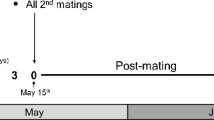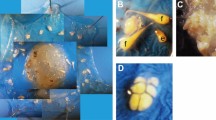Abstract
Aplysia californica, an opisthobranch mollusc, possesses a complex reproductive system that includes a seminal receptacle for the storage of exogenous sperm received from mating. Based on this reproductive anatomy, A. californica should have the ability to maintain and use viable exogenous sperm stores to fertilize multiple eggmasses for extended periods of time. Using controlled matings and careful observation of the development of eggmasses over time, we attempted to quantify A. californica’s ability to store and use exogenous sperm following a single mating. On average, A. californica (240.6±31.7 g; mean±SE, n=9) produced 8.8±0.6 eggmasses containing 16.9±2.2×106 fertilized eggs over a period of 22.3±3.6 days following a single mating encounter. The maximum duration an individual A. californica produced fertilized eggs, following a single copulation, was 41 days. The primary factor determining the cumulative number of fertilized eggs produced from a single mating in A. californica was the mass of the sperm recipient (r=0.773, P<0.05, n=9). Our results demonstrated that A. californica are not sperm limited following a single mating as has been suggested for other opisthobranch molluscs by Leonard and Lukowiak’s (1991) gamete-trading hypothesis.


Similar content being viewed by others
References
Beeman RD (1970) An autoradiographic study of sperm exchange and storage in a sea hare, Phyllaplysia taylori, a hermaphroditic gastropod (Ophisthobranchia: Anaspidea). J Exp Zool 175:125–132
Birkhead TR (1993) Sexual selection and temporal separation of reproductive events: sperm storage data from reptiles, birds and mammals. Biol J Linn Soc 50:295–311
Capo TR, Fieber LA, Stommes DL, Walsh PJ (2002) The effect of stocking density on growth rate and maturation time in laboratory-reared California sea hares. Contemp Top Lab Anim 41:18–23
Carefoot TH (1987) Aplysia : its biology and ecology. Oceanogr Mar Biol 25:167–284
Charnov EL (1979) Simultaneous hermaphroditism and sexual selection. Proc Natl Acad Sci USA 76:2480–2484
Hadfield MG, Switzer-Dunlap M (1984) Ophistobranchs. In: Tompa AS, Verdonk NH, van der Biggelaar JAM (eds) The mollusca, vol 7, reproduction. Academic Press, London, pp 209–350
Kandel ER (1979) Behavioral biology of Aplysia. Freeman, San Francisco, Calif.
Kandel P, Capo TR (1979) The packaging of ova in the egg cases of Aplysia californica. Veliger 22:194–198
Leonard JL (1991) Sexual conflict and the mating systems of simultaneously hermaphroditic gastropods. Am Malacol Bull 9:45–58
Leonard JL, Lukowiak K (1985) Courtship, copulation, and sperm trading in the sea slug, Navanax inermis (Opisthobranchia: Cephalaspidea). Can J Zool 63:2719–2729
Leonard JL, Lukowiak K (1986) The behavior of Aplysia californica Cooper (Gastropoda; Opisthobranchia): I. Ethogram. Behavior 98:320–360
Leonard JL, Lukowiak K (1991) Sex and the simultaneous hermaphrodite: testing models of male-female conflict in a sea slug, Navanax inermis (Opisthobranchia). Anim Behav 41:255–266
MacGinitie GE (1934) The egg-laying activities of the sea hare, Tethys californicus (Cooper) Biol Bull (Woods Hole) 67:300–303
Painter SD (1992) Coordination of reproductive activity in Aplysia: Peptide neurohormones, neurotransmitters, and pheromones encoded by the egg-laying hormone family of genes. Biol Bull (Woods Hole) 183:165–172
Pearse DE, Janzen FJ, Avise JC (2001) Genetic markers substantiate long-term storage and utilization of sperm by female painted turtles. Heredity 86:378–384
Pennings SC (1991) Reproductive behavior of Aplysia californica Cooper; diel patterns, sexual roles, and mating aggregations. J Exp Mar Biol Ecol 149:249–266
Wethington AR, Dillon RT (1991) Sperm storage and evidence for multiple insemination in a natural population of the freshwater snail, Physa. Am Malacol Bull 9:89–98
Yusa Y (1994a) Factors regulating sperm transfer in a hermaphroditic sea hare, Aplysia parvula Morch, 1863 (Gastropoda: Ophistobranchia). J Exp Mar Biol Ecol 181:213–221
Yusa Y (1994b) Size-related egg production in a simultaneous hermaphrodite, the sea hare Aplysia kurodai Baba. Publ Seto Mar Biol Lab 36:249–254
Yusa Y (1996a) The effects of body size on mating features in a field population of the hermaphroditic sea hare Aplysia kurodai Baba, 1937 (Gastropoda: Ophistobranchia). J Mollusc Stud 62:381–386
Yusa Y (1996b) Utilization and degree of depletion of exogenous sperm in three hermaphroditic sea hares of the genus Aplysia (Gastropoda: Opisthobranchia). J Mollusc Stud 62:113–120
Acknowledgements
All of the Aplysia californica used in this experiment were obtained from the University of Miami, NIH National Resource for Aplysia. This research was supported by an NIH grant (RR 10294) to Dr. Patrick J. Walsh and the National Resource for Aplysia. We would like to thank all of the staff at the University of Miami, NIH National Resource for Aplysia for providing space and technical support. A special thanks to Ana Bardales, Tom Capo, and Dustin Stommes for their expertise and support in breeding and rearing of larval and juvenile A. californica. The experiment conducted complies with the current laws of the USA.
Author information
Authors and Affiliations
Corresponding author
Additional information
Communicated by P.W. Sammarco, Chauvin
Rights and permissions
About this article
Cite this article
Ludwig, A.N., Walsh, P.J. Sperm storage and use in laboratory-reared Aplysia californica, a simultaneous hermaphrodite. Marine Biology 145, 727–732 (2004). https://doi.org/10.1007/s00227-004-1358-y
Received:
Accepted:
Published:
Issue Date:
DOI: https://doi.org/10.1007/s00227-004-1358-y




